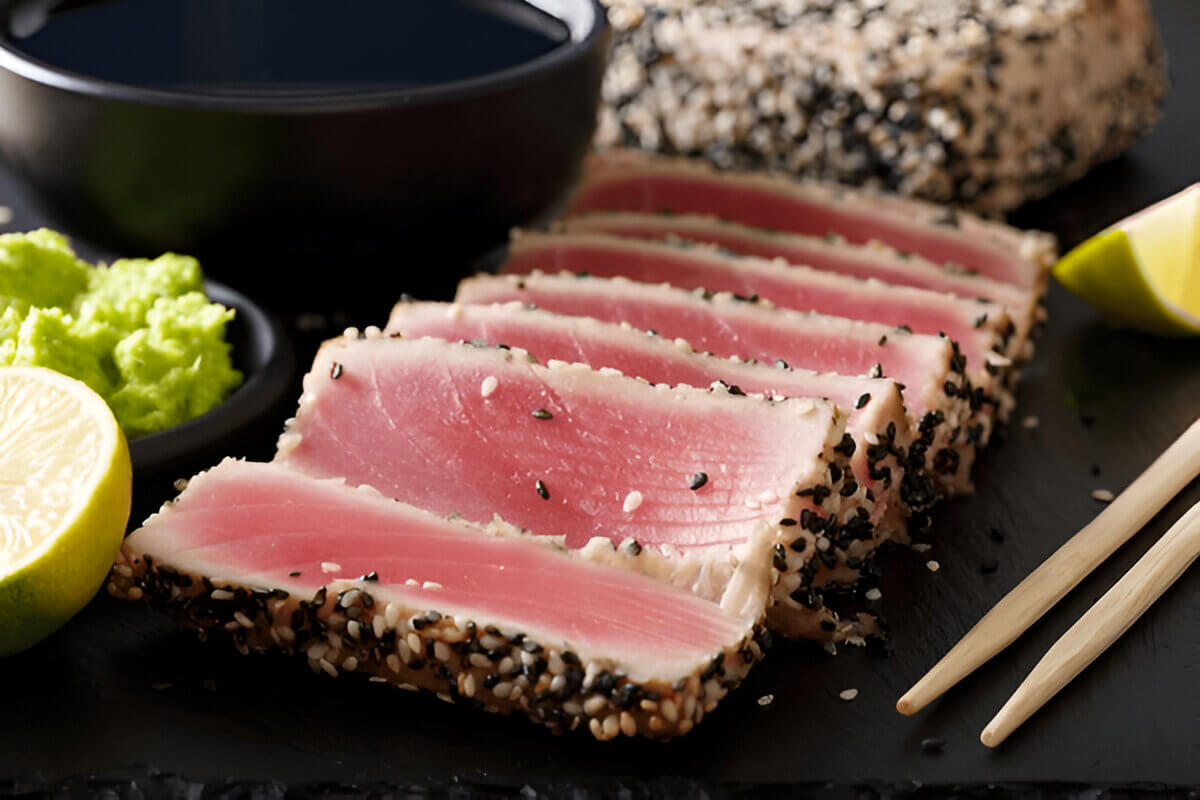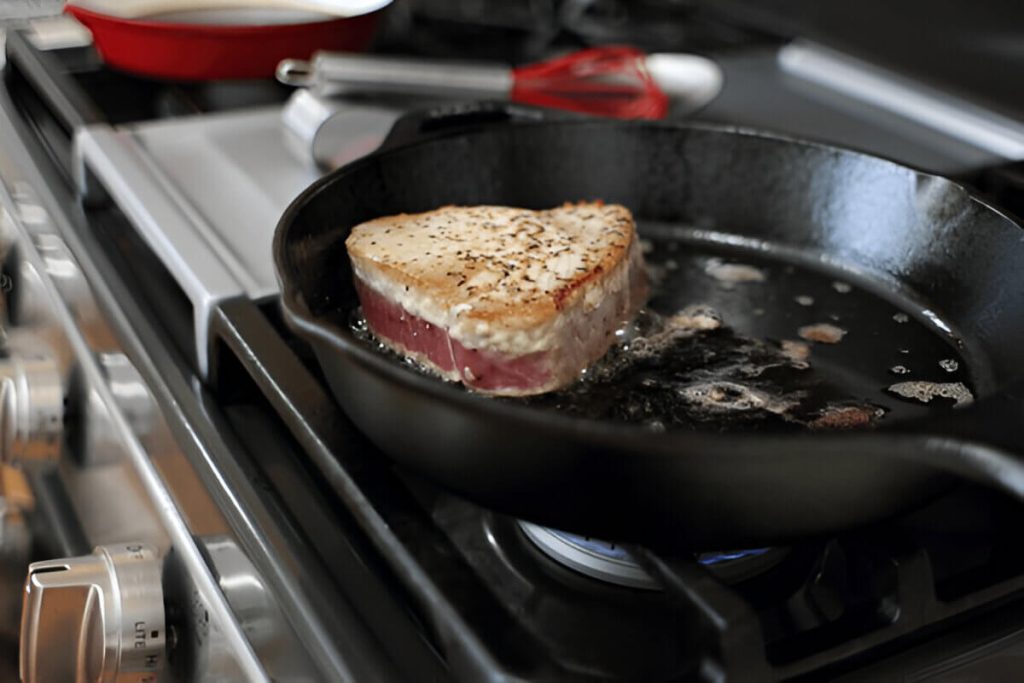
Ahi tuna, or yellowfin tuna, is cherished for its delicate flavor and tender texture. Popular among seafood lovers, it offers exquisite taste and health benefits. This guide covers cooking ahi tuna perfectly, from selecting quality fish to using expert preparation methods like searing, grilling, or baking. It includes step-by-step instructions and complementary sides and sauces for delicious, healthy meals with this versatile seafood.
Selecting the Best Ahi Tuna for Cooking
When it comes to selecting the best ahi tuna for cooking, understanding the nuances of quality is essential. Whether you’re planning to prepare a delectable seared tuna dish or crafting sushi at home, choosing the right ahi tuna can make all the difference.
First and foremost, freshness is key when selecting ahi tuna. Look for fish that has a vibrant red color, as this indicates freshness and quality. If you’re purchasing from a fish market or grocery store, don’t hesitate to ask when the fish was caught or delivered. Freshness can often be determined by smell, fresh ahi tuna should have a clean ocean scent without any overpowering fishy odor.
For those interested in sushi-grade ahi tuna, it’s important to understand what this label means. Sushi-grade refers to fish that has been frozen at very low temperatures to kill parasites, making it safe for raw consumption. When buying sushi-grade ahi tuna, ensure that it’s labeled accordingly and sourced from reputable suppliers who follow strict handling practices.
Another crucial aspect of selecting high-quality ahi tuna is examining its texture. The flesh should be firm yet slightly springy when touched. If the meat appears mushy or leaves an indentation after pressing gently with your finger, it’s best to avoid it.
Lastly, consider purchasing wild-caught over farm-raised options whenever possible. Wild-caught ahi tends to have better flavor profiles and fewer additives compared to its farmed counterparts.
Preparing Ahi Tuna (Tips and Techniques)
When it comes to preparing ahi tuna steaks, achieving the perfect balance of flavor and texture is key. Start by selecting sushi-grade fish, which ensures the highest quality and safety for raw consumption. Look for bright red flesh with a firm texture, indicating freshness.
Marinating techniques can greatly enhance the natural taste of ahi tuna. A simple marinade of soy sauce, sesame oil, ginger, and garlic can infuse the steaks with rich flavors without overpowering their delicate taste. Allow the tuna to marinate for about 30 minutes to an hour in the refrigerator; this helps tenderize the meat while imparting depth.
Seasoning ideas can vary widely depending on your preference. For a classic approach, consider a light sprinkle of salt and pepper before searing or grilling. For those looking to experiment with bolder flavors, try crusting your ahi tuna steaks with sesame seeds or crushed peppercorns before cooking.
Prepping sushi-grade fish also requires attention to detail. Ensure that all surfaces and utensils are clean to maintain food safety standards when handling raw fish. Additionally, use a sharp knife for precise cuts that preserve the integrity of the tuna’s texture.
By mastering these tips and techniques, you can create delicious ahi tuna dishes that highlight both its natural qualities and your personal culinary style.
Step-by-Step Instructions for Cooking Ahi Tuna on the Stovetop

Achieving the perfect sear on ahi tuna steaks is a delightful culinary skill that can elevate your home-cooked meals. Here’s a step-by-step guide to mastering this technique on your stovetop.
- Select Quality Tuna: Start by choosing fresh, sushi-grade ahi tuna steaks. The quality of the fish is crucial for both taste and texture.
- Prepare the Steaks: Pat the tuna steaks dry with paper towels to remove excess moisture, which helps in achieving a good sear. Season them generously with salt and pepper or your choice of spices.
- Preheat Your Pan: For an optimal sear, use a heavy-bottomed pan or skillet and heat it over medium-high heat until it’s hot enough that water droplets sizzle upon contact.
- Add Oil: Once the pan is hot, add a high smoke point oil like canola or avocado oil to prevent sticking and ensure even cooking.
- Sear the Tuna: Place the seasoned ahi tuna steaks in the pan without overcrowding them. Allow each side to cook for about 1-2 minutes, depending on thickness, until they develop a golden-brown crust but remain rare in the center, this is key for maintaining their tender texture.
- Check Cooking Temperatures: Ideally, ahi tuna should be cooked to an internal temperature of around 115°F (46°C) for rare doneness. Use an instant-read thermometer if precision is desired.
- Rest Before Serving: Let the seared tuna rest for a few minutes before slicing it against the grain to preserve its juices and tenderness.
Grilling and Baking Ahi Tuna Steaks (Alternative Methods)
When it comes to preparing ahi tuna steaks, both grilling and baking offer delicious alternatives that bring out the rich flavors of this prized fish. Each method has its unique approach, allowing you to enjoy yellowfin tuna in different ways.
For those who love the smoky and charred essence of outdoor cooking, a grilled ahi tuna recipe is an excellent choice. Start by marinating the steaks with a blend of soy sauce, garlic, ginger, and sesame oil for about 30 minutes to enhance their natural taste. Preheat your grill to high heat and sear the tuna for about 2-3 minutes on each side. The goal is to achieve a beautifully charred exterior while keeping the center rare or medium-rare for optimal flavor and texture.
On the other hand, if you’re seeking a more controlled cooking environment or simply prefer indoor preparation, consider the baked ahi tuna method. Preheat your oven to 400°F (200°C) and place seasoned ahi tuna steaks on a baking sheet lined with parchment paper. You can add toppings like lemon slices or herbs for added flavor. Bake for approximately 10-12 minutes until they reach your desired level of doneness.
Both methods provide delightful cooking alternatives for yellowfin tuna that cater to different preferences in taste and texture. Whether you opt for grilling’s robust flavors or baking’s gentle heat, these techniques ensure that your ahi tuna steaks are cooked to perfection every time.
Delicious Sides and Sauces that Enhance Ahi Tuna Flavor
When it comes to elevating the delicate flavor of ahi tuna, the right sides and sauces can make all the difference. Whether you’re preparing a seared yellowfin steak or another variation, pairing it with complementary flavors is key to a memorable meal.
For sauces, consider options that enhance rather than overpower the tuna. A classic choice is a soy-ginger glaze, which adds a savory and slightly sweet touch that complements the fish’s natural richness. Alternatively, try a wasabi aioli for a kick of heat balanced by creamy undertones. Citrus-based sauces like lemon or lime vinaigrette can also add brightness and acidity, cutting through the richness of seared ahi tuna.
When selecting side dishes for your yellowfin steak, aim for textures and flavors that complement its tender profile. A light cucumber salad with sesame oil offers refreshing crunch and subtle nutty notes. For something heartier, consider garlic-infused quinoa or jasmine rice as they provide a satisfying base without overwhelming the palate.
Pairing wines with seared fish requires careful consideration to enhance your dining experience further. A crisp Sauvignon Blanc or an unoaked Chardonnay pairs beautifully with ahi tuna’s delicate flavors due to their vibrant acidity and subtle fruitiness. If you prefer red wine, opt for a light Pinot Noir; its low tannin content won’t clash with the fish’s texture.
Nutritional Benefits of Including Ahi Tuna in Your Diet
Ahi tuna, a popular choice among seafood enthusiasts, offers a plethora of nutritional benefits that make it an excellent addition to your diet. One of the most notable health benefits of eating fish like ahi tuna is its rich content of omega-3 fatty acids. These essential fats play a crucial role in maintaining heart health by reducing inflammation, lowering blood pressure, and improving overall cardiovascular function.
In addition to its heart-healthy properties, ahi tuna is also an exceptional source of high-quality protein. This makes it an ideal choice for those seeking protein-rich seafood options to support muscle growth and repair. Unlike some other protein sources, ahi tuna is low in saturated fat, making it a lean option that supports weight management and overall wellness.
Moreover, ahi tuna is packed with essential vitamins and minerals such as vitamin D, selenium, and magnesium. These nutrients contribute to various bodily functions including immune support, bone health, and energy production. By incorporating ahi tuna into your meals regularly, you can enjoy these comprehensive nutritional benefits while savoring its delicious flavor profile.